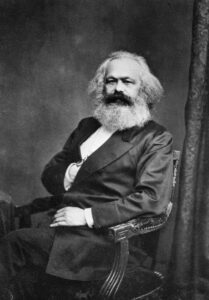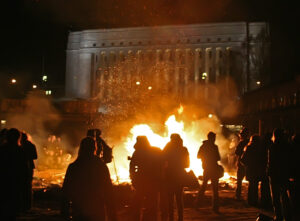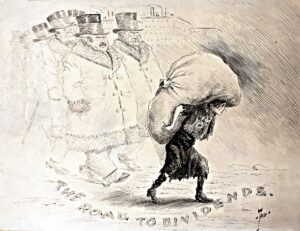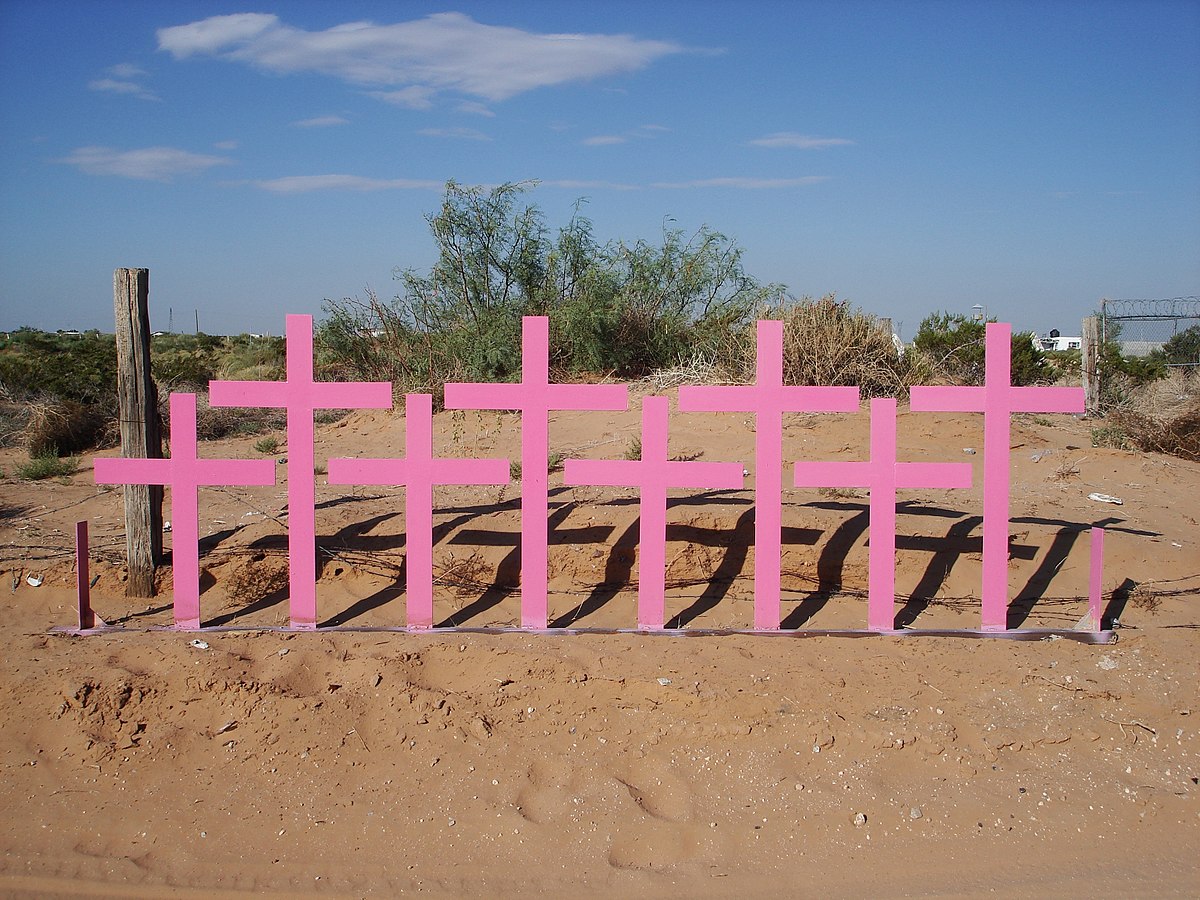A Marxist Analysis of The Hunger Games and The Purge Series
There’s a particular moment in the 2012 film adaptation of Suzanne Collins’ award-winning series The Hunger Games that still stands out years after revisiting it. Very early on in the movie, the protagonist Katniss Everdeen is asked to perform for the Gamemakers, an elite group of rich men and women who judge the Hunger Games, a survivalist competition where the lower class from each district are forced to fight in a bloody battle royale. After failing to miss her first shot and getting dismissed by the Gamemakers even when hitting a bullseye on her second try, Katniss nails her final shot into an apple in the mouth of the Gamemakers’ stuffed pig dinner. In this moment, the line between spectator and competitor is broken. Katniss, as member of the lowest class of District 12 proves herself as a worthy force to be reckoned with and although both she (and the audience) doesn’t know it yet, this was the rumblings of a rebellion yet to come.
Why is this moment highlighted in relation to famous philosopher and sociologist Karl Marx? This was a small example of his study known as conflict theory, or a macro theory based on class struggles and exploitation. As you keep reading, consider this moment as a microcosm of conflict theory and the larger implications it brings to the discussion later.
Part I. Marx and the Beginnings of Conflict

Before we can dive deeper into The Hunger Games, what exactly is conflict theory and where did it come from? The term was coined by Marx in his 1848 novel The Communist Manifesto, where he believed that society at the time was being perpetuated by conflicts between the bourgeoisie and the proletariat. The bourgeoisie, or the small minority who were the wealthy class were the highest members of society at the time because of their wealth and status as cultural elites and could have total control over the making of goods at the time, such as land distribution and factories. On the other hand, the proletariat, or the majority, who were the poor, property-less industrial working class were the ones who worked for labor in order to obtain some type of wage or pay. In most situations, the bourgeoisie had absolute control over the pay, which to the proletariat was an unjust situation of overworked, uncompensated labor. Although the terms “bourgeoisie” and “proletariat” aren’t common in modern day vernacular, contemporary scholars are still fascinated by how the conflict between the bourgeoisie and proletariat shaped societal structures.
In her article, “Conflict Theory in Sociology” author Charlotte Nickerson paints an example of how the bourgeoisie had a habit of twisting the proletariat under their control. “If the power of the ruling class is challenged by, say, strikes and protests, the ruling class can use the law to criminalize those posing a threat, and media reporting will be manipulated to give the impression that the ruling class’s interests are those of the whole nation” (Nickerson). This led to the creation of a more refined social structure, or the distinctive and stable arrangements of social patterns that form the society as a whole. This example of a class-based social structure could even be seen dating back to the 17th century and Marie Antionette’s famous “Let them eat cake!” being shown in films such as 2014’s Mr. Peabody and Sherman. With this class divide, comes conflict, leading to revolution. And so, we return to The Hunger Games.
Part II: May the Odds Be Ever in Your Favor
The basis of The Hunger Games goes much deeper than just a single event centered around entertaining the elite class, like when Katniss is expected to wave in a parade for the Capitol citizens in honor of the Games. In reality, The Hunger Games represent the fight for dominance in a warring society. In her essay, “Economic Inequality in Suzanne Collins’ The Hunger Games: A Marxist Reading,” author Sofie Pettersson illustrates how Collins shows the power difference between the Capitol and the Districts based on status.
 “According to Katniss, the message of the Games is clear: ‘Look at how we take your children and sacrifice them and there’s nothing you can do. If you lift a finger, we will destroy every last one of you’” (Pettersson, page 18).
“According to Katniss, the message of the Games is clear: ‘Look at how we take your children and sacrifice them and there’s nothing you can do. If you lift a finger, we will destroy every last one of you’” (Pettersson, page 18).
The Games themselves could be seen as a way for the proletariat to rebel and fight against the system that they are under. However, the bourgeoisie Capitol, see the Games as only entertainment and encourage participants to treat it as such. This leads to an opportunity such as the Cornucopia, the opening moment of the game for participants to fight over resources such as food and weapons to possibly gain an advantage. It is evident that even in this scene (as well as the earlier pig scene), the film shows the struggle between the Capitol and the Districts. The overarching class conflict would build all the way throughout the second book Catching Fire and the eventual rebellion in Mockingjay. The proletariat Districts, even recontextualize the phrase “may the odds be ever in your favor” from a phrase used by the Capitol at the start of the games to a rallying cry for their eventual downfall. However, what would happen if all power was equal between the two? That’s when you get The Purge.
Part III: Violence, “Justice” and Rebellion
 Written and directed by James Demonaco, The Purge series reveals the violence-obsessed consumerism nature of America and allows no limits to its political messaging around gun control and hedonistic violence. Although the film series does discuss more political themes, conflict theory can be viewed in these movies. While not as overt as The Hunger Games, The Purge still offers insight into how a potentially extreme example of modern conflict theory could be demonstrated. The concept of The Purge is simple; on one night of the year any crime, or an offence in violation of public law, is legal for a twelve-hour period, including murder. This event (in theory) would allow for the natural evolution of the strongest and smartest surviving while allowing for Americans to reach a more utopic state by giving into their primal, animalistic urges. The “purge” secretly allows for the American economic system of firearm sales and security systems to flourish in order to allow protection from purging. Because of this, there is a fight for resources in order to gain advantage over the systematic societal pressure of the predicted violence (much in the same way as The Hunger Games’ Cornucopia). In addition to this, the original founding of the Purge was brought on by a new political party known as The New Founding Fathers of America. Their goal was to try and reduce severe social issues like rising crime rates and unemployment, but as author Liviu Alexandrescu states in his essay, “Violence, crime dystopia and the dialectics of (dis)order in The Purge films,” this system only leads to differing levels of violence.
Written and directed by James Demonaco, The Purge series reveals the violence-obsessed consumerism nature of America and allows no limits to its political messaging around gun control and hedonistic violence. Although the film series does discuss more political themes, conflict theory can be viewed in these movies. While not as overt as The Hunger Games, The Purge still offers insight into how a potentially extreme example of modern conflict theory could be demonstrated. The concept of The Purge is simple; on one night of the year any crime, or an offence in violation of public law, is legal for a twelve-hour period, including murder. This event (in theory) would allow for the natural evolution of the strongest and smartest surviving while allowing for Americans to reach a more utopic state by giving into their primal, animalistic urges. The “purge” secretly allows for the American economic system of firearm sales and security systems to flourish in order to allow protection from purging. Because of this, there is a fight for resources in order to gain advantage over the systematic societal pressure of the predicted violence (much in the same way as The Hunger Games’ Cornucopia). In addition to this, the original founding of the Purge was brought on by a new political party known as The New Founding Fathers of America. Their goal was to try and reduce severe social issues like rising crime rates and unemployment, but as author Liviu Alexandrescu states in his essay, “Violence, crime dystopia and the dialectics of (dis)order in The Purge films,” this system only leads to differing levels of violence.
Subjective violence can prop up objective violence, such as in the use of armed violence mobilised by states to guard land enclosures, private property and drive off communities into low wage jobs and destitution.” (Alexandrescu, 567-568).
 This could also be seen in the Enclosure Movement in England in the 17th century. During this time, wealthy English landowners were converting public land that was previously owned by communities and turning it into sectioned off private property. These actions led to organized riots and protests by farmers that were quickly shut down by the English landowners, making way for the rise of capitalism and industrial revolution. Even though the conflicts are vastly different, this could also be seen in The Purge. Although the use of violence is glorified within The Purge series, a Marxist reading of the franchise shows that although conflict is seen as a problem-solving solution, the underlying theme of proletariat rebellion still holds strong as a way of economic equilibrium within the larger social structure. Marx would view the Purge as unfair to middle/class since the higher-class bourgeoisie would be fundamentally better off in surviving because of their higher economic status. Their place in society would allow them access to better resources, such as weapons and safehouses for protection that would give them a distinct edge for guaranteed survival.
This could also be seen in the Enclosure Movement in England in the 17th century. During this time, wealthy English landowners were converting public land that was previously owned by communities and turning it into sectioned off private property. These actions led to organized riots and protests by farmers that were quickly shut down by the English landowners, making way for the rise of capitalism and industrial revolution. Even though the conflicts are vastly different, this could also be seen in The Purge. Although the use of violence is glorified within The Purge series, a Marxist reading of the franchise shows that although conflict is seen as a problem-solving solution, the underlying theme of proletariat rebellion still holds strong as a way of economic equilibrium within the larger social structure. Marx would view the Purge as unfair to middle/class since the higher-class bourgeoisie would be fundamentally better off in surviving because of their higher economic status. Their place in society would allow them access to better resources, such as weapons and safehouses for protection that would give them a distinct edge for guaranteed survival.
Conflict theory can vary from the simplistic sounding origins of “rich” versus “poor” class structures. The Hunger Games prequel, Sunrise on the Reaping, is expected on March 18th, 2025. The book will allow readers to consider how these systems have evolved into the depiction of the 74th Hunger Games shown in the first novel.
Polley is a guest blogger at UITAC Publishing. UITAC’s mission is to provide high-quality, affordable, and socially responsible online course materials.
Images Used in this Blog:
- “Karl Marx 001” by John Jabez Edwin Mayall from Wikimedia Commons is licensed under the public domain. This image has not been altered.
- “Hunger Games Book Collection” by ajay_suresh from Wikimedia Commons is licensed under the Creative Commons Attribution 2.0 Generic license. This image has not been altered.
- “The Finnish May Day “riot”” by Ville Oksanen from Wikimedia Commons is licensed under the Creative Commons Attribution-Share Alike 2.0 Generic license. This image has not been altered.
- “The Road to Dividends, caricature by Tad Dorgan” by Tad Dorgan from Wikimedia Commons is licensed under the public domain. This image has not been altered.




